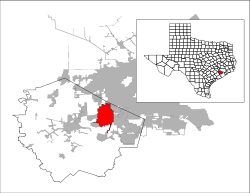Sugar Land, TX
| Sugar Land, Texas | ||
|---|---|---|
| City | ||
| City of Sugar Land | ||

Sugar Land Town Square, First Colony in 2010
|
||
|
||
 Location in Fort Bend County, Texas |
||
| Coordinates: 29°35′58″N 95°36′51″W / 29.59944°N 95.61417°WCoordinates: 29°35′58″N 95°36′51″W / 29.59944°N 95.61417°W | ||
| Country | United States | |
| State | Texas | |
| County | Fort Bend | |
| Government | ||
| • Type | Council-Manager | |
| • City Council |
Mayor James A. Thompson Himesh Gandhi Joe Zimmerman Steve Porter Bridget Yeung Amy Mitchell Carol McCutcheon |
|
| • City Manager | Allen Bogard | |
| Area | ||
| • Total | 34.0 sq mi (88.1 km2) | |
| • Land | 32.4 sq mi (83.9 km2) | |
| • Water | 1.6 sq mi (4.2 km2) | |
| Elevation | 100 ft (30 m) | |
| Population (2010) | ||
| • Total | 78,817 | |
| • Estimate (2015) | 88,156 | |
| • Density | 2,723/sq mi (1,051.2/km2) | |
| Time zone | Central (CST) (UTC-6) | |
| • Summer (DST) | CDT (UTC-5) | |
| ZIP codes | 77478-79, 77487, 77496, and 77498 | |
| Area code(s) | Mostly 281 also 713, 832, and 346 | |
| FIPS code | 48-70808 | |
| GNIS feature ID | 1348034 | |
| Website | www |
|
Sugar Land is a city in Fort Bend County, Texas, United States, within the Houston–The Woodlands–Sugar Land metropolitan area. It is one of the most affluent and fastest-growing cities in Texas, having grown more than 158 percent between 2000 and 2010. In the time period of 2000–2007, Sugar Land also enjoyed a 46.24% job growth. As of the 2010 census, the city's population was 78,817. In 2015 the population had risen to an estimated 88,156. Founded as a sugar plantation in the early mid-20th century and incorporated in 1959, Sugar Land is the largest city and economic center of Fort Bend County.
Sugar Land is home to the headquarters of Imperial Sugar, and the company's main sugar refinery and distribution center were once located in the city. Recognizing this heritage, the Imperial Sugar crown logo can be seen in the city seal and logo.
Sugar Land's heritage traces its roots back to the original Mexican land grant to Stephen F. Austin. One of the first settlers of the land, Samuel M. Williams, called this land "Oakland Plantation" because there were many different varieties of oaks on the land, such as willow oak, post oak, water oak, southern red oak, and live oak. Williams' brother, Nathaniel, purchased the land in 1838. They operated the plantation by growing cotton, corn, and sugarcane. During these early years, the area that is now Sugar Land was the center of social life along the Brazos River. In 1853, Benjamin Terry and William J. Kyle purchased the Oakland Plantation from the Williams family. Terry is known for organizing Terry's Texas Rangers during the Civil War and for naming the town. Upon the deaths of Terry and Kyle, Colonel E. H. Cunningham bought the 12,500-acre (5,100 ha) plantation soon after the Civil War, and developed the town around his sugar-refining plant around 1879.
...
Wikipedia

